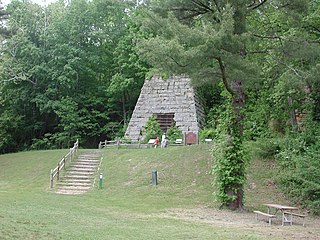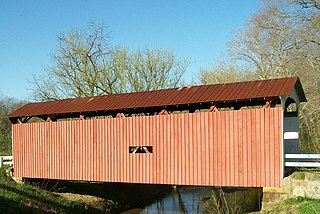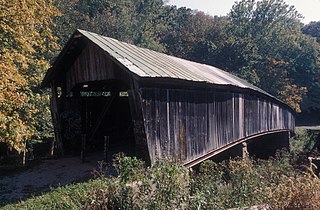
The National Road was the first major improved highway in the United States built by the federal government. Built between 1811 and 1837, the 620-mile (1,000 km) road connected the Potomac and Ohio Rivers and was a main transport path to the West for thousands of settlers. When improved in the 1830s, it became the second U.S. road surfaced with the macadam process pioneered by Scotsman John Loudon McAdam.

The Jackson's Sawmill Covered Bridge or Eichelberger's Covered Bridge is a covered bridge that spans the West Branch of the Octoraro Creek in Lancaster County, Pennsylvania, United States. A county-owned and maintained bridge, its official designation is the West Octoraro #1 Bridge. The bridge is purportedly the only covered bridge in the county that is not built perpendicular to the stream it crosses due to the placement of the sawmill on one side of the bridge and the rock formations faced by the builders on the other side.

Vinton County is a county located in the U.S. state of Ohio. As of the 2020 census, the population was 12,800, making it the least populous county in the state. Its county seat is McArthur. The county is named for Samuel Finley Vinton, US Representative from Ohio.

The Smithfield Street Bridge is a lenticular truss bridge crossing the Monongahela River in Pittsburgh, Pennsylvania, USA.

The Monongahela Incline is a funicular located near the Smithfield Street Bridge in Pittsburgh, Pennsylvania. Designed and built by Prussian-born engineer John Endres in 1870, it is the oldest continuously operating funicular in the United States.

Hunting Lodge Farm is a historic house located near Oxford in Oxford Township, Butler County, Ohio, United States. Constructed as a hunting lodge, it has been used by multiple prominent local residents, and its distinctive architecture has made it worthy of designation as a historic site.

This is a list of the National Register of Historic Places listings in Vinton County, Ohio.

The McColly Covered Bridge is a historic wooden covered bridge in western Logan County, Ohio, United States. Located in Washington Township near the community of Bloom Center, it is one of two remaining covered bridges in Logan County. It carries County Road 13 over the Great Miami River, approximately 5 miles (8.0 km) south of its source at Indian Lake.

The Lockington Covered Bridge was a historic covered bridge that once spanned the Great Miami River near Lockington, Ohio, United States. Built in 1848, it employed the Long Truss method of construction. Construction elements included vertical wooden siding, wooden structural elements, wooden shingles on its roof, and cut stone abutments. Measuring approximately 170 feet (52 m) long, the bridge was composed of two spans; it cost $1,500 to build.
The Zaleski Mound Group is a collection of three burial mounds in the village of Zaleski, Ohio, United States. Built by people of the prehistoric Adena culture, these earthworks are valuable archaeological sites.

The Hope Furnace is a historic blast furnace in the southeastern part of the U.S. state of Ohio. Located along State Route 278, approximately 5 miles (8.0 km) northeast of the village of Zaleski, it is one of two extant iron furnaces in Vinton County. Between 1854 and 1874, the furnace was used to smelt iron ore, using coal or charcoal for fuel. It is a rectangular structure, built of sandstone and shaped like a truncated pyramid.

The Eakin Mill Covered Bridge is a historic covered bridge in Vinton County, Ohio, United States. Located southeast of the county seat of McArthur, this bridge carries Mound Hill Road near the community of Arbaugh.

The South Salem Covered Bridge is a historic covered bridge in northwestern Ross County, Ohio, United States. It was built in the 1870s and has been designated a historic site because of its well-preserved historic engineering. Since its construction, it has carried Lower Twin Road over Buckskin Creek in Buckskin Township. The bridge is a wooden Smith truss bridge, built in 1873 according to a design patented by Ohioan Robert Smith in the late 1860s. Eight wooden panels wide, it rests on stone abutments and is covered with a metal roof.

The Foreaker Covered Bridge, with the first word sometimes spelled Foraker, and also called the Weddle Covered Bridge, is located on Monroe County Road 40, three miles east of Graysville, Ohio. The property was listed on the National Register in 1975.

The Root Covered Bridge is a historic wooden covered bridge in the southeastern part of the U.S. state of Ohio. Located off State Route 555 in far northern Decatur Township, Washington County, the bridge was built in 1878 in the Long truss mode of truss bridge construction. Measuring 65 feet (20 m) in its single span, it spans the West Branch of the Little Hocking River.

The Mull Covered Bridge is a historic wooden covered bridge in the northwestern portion of the U.S. state of Ohio. Built in the middle of the nineteenth century, it is located near Burgoon in Sandusky County. Although it is no longer used to facilitate transportation, the bridge has been preserved and is now a historic site.

The Christman Covered Bridge is a historic covered bridge that carries Eaton-New Hope Road over Seven Mile Creek in Washington Township, Preble County, Ohio, United States, northwest of the city of Eaton. It was built in 1895 by Everett S. Sherman, who built at least 20 covered bridges in Preble County. It was listed on the National Register of Historic Places in 1976.

The Ballard Road Covered Bridge is a historic wooden covered bridge in the southwestern part of the U.S. state of Ohio. Built in the late nineteenth century and since bypassed, the bridge has been named a historic site.

The Ponn Humpback Covered Bridge was a historic covered bridge in the southeastern part of the U.S. state of Ohio. Located near the village of Wilkesville in Vinton County, it bore a name derived from its unusual shape: the bridge was arched in the middle, rather than being flat like a typical covered bridge. Declared a historic site in the 1970s, the bridge had a history closely tied to arson — it was constructed to replace a bridge that had been burned intentionally, and it met its end at the hands of an arsonist.

The Kidwell Covered Bridge, in Dover Township, Athens County, Ohio between the nearby hamlets of Truetown and Redtown, was built in 1880. It spans Sunday Creek. It was listed on the National Register of Historic Places in 1977.






















